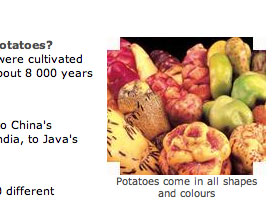The Ethiopian Biodiversity Conservation Institute has reported on a variety of efforts to conserve and make better use of medicinal plants. Lots of interesting snippets of information, and some ideas others may find worthwhile. Head on over to AllAfrica.com for the story. The Institute has a web site here, with medicinal plants here. There’s also one for the Institute of Biodiversity Conservation and Research. I can’t figure out the relationship between the two.
Starch grains and the origins of agriculture
A couple of papers discussed here and here (among other places: the chili pepper story in particular has been getting a lot of media coverage) describe how the minute, species-characteristic starch grains found in micro-crevices on stone tools and cooking utensils recovered from archaelogical sites are being used to study the domestication of crops as varied as maize, cassava and chilies in the Americas. The findings are pushing back the timing of domestication and suggesting that wet lowland areas were more important in the process than previously thought. Jeremy blogs on the chili angle at greater length here. No word on the past of cactus cultivation, at least in these papers, but this piece suggests its future may be troubled.
The marula and the elephant
The sweet, juicy fruits of the marula tree (Sclerocarya birrea) are widely eaten in the miombo woodlands of southern Africa, and are also used to make the delicious Amarula Cream liqueur. But it’s not just people who like them: elephants will walk a long way for a marula feast. This piece looks at some of the evolutionary consequences.
Brazil to market biodiversity
Under an Environment Ministry initiative in Brazil research groups have selected 775 species to encourage production and hopefully develop major markets. Read about it here:
Five books will be published this year, each dedicated to one of the five major regions of Brazil, containing the knowledge that has been accumulated about these “plants of the future”. Seminars for the business community will be held to spread the word about the potential of these plants, which are ornamental or used to produce foods, beverages, medicines, oils and perfumes.
Too delicious
Q: When is potato diversity not potato diversity?
A: When it is in the hands of assorted experts.
 I hate to be pedantic here. (Actually, that’s a terrible lie; I love to be pedantic, especially about crops and food.) But if you look closely at the photograph, and you know your tubers, you’ll know that those aren’t potatoes in the picture. They are oca and mashua. Andean tubers, to be sure, but not potatoes. So who made this elemental error? None other than the good folks at the International Year of the Potato.
I hate to be pedantic here. (Actually, that’s a terrible lie; I love to be pedantic, especially about crops and food.) But if you look closely at the photograph, and you know your tubers, you’ll know that those aren’t potatoes in the picture. They are oca and mashua. Andean tubers, to be sure, but not potatoes. So who made this elemental error? None other than the good folks at the International Year of the Potato.
Worse, it’s on the page specifically addressed “Hey, kids!” (Lord how I love that exciting exclamation mark.) One could, of course, argue that the caption just happens to be underneath a photo of other Andean tubers. But that won’t wash. What we have here is a total and abject failure to know anything whatsoever about potatoes. How can kids! trust anything else on the page?
I’m sure that the International Year of the Potato will be a good thing, just as the International Year of Rice was a good thing. I’m equally sure someone will eventually detect this egregious and appalling error. In the meantime, just to be on the safe side, I snapped the page and am preserving it here for posterity.
And hey, potato people, my rates remain reasonable.